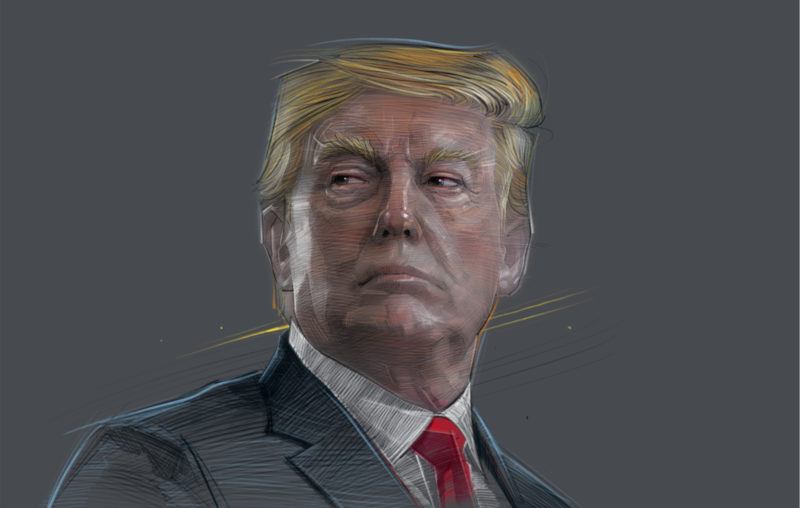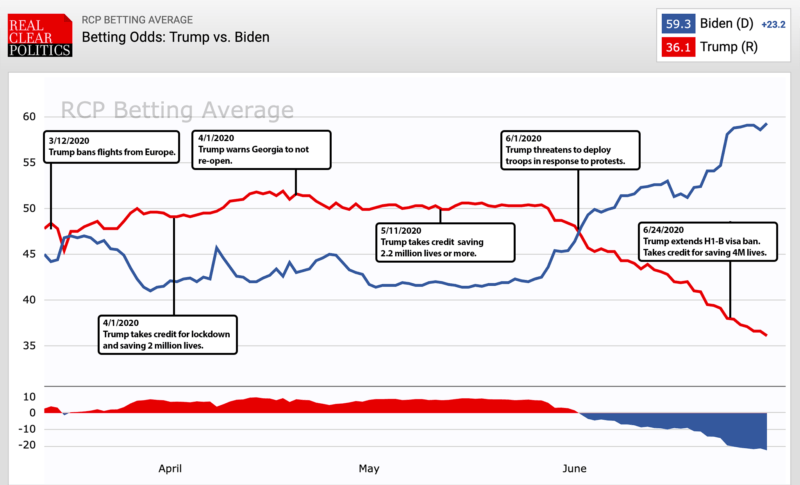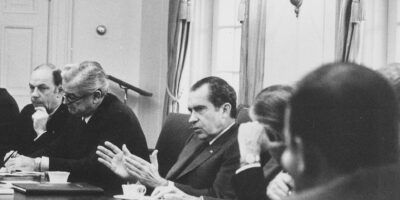Why Election Markets are Betting Against Trump

The betting markets judge Trump’s prospects for keeping the presidency with more negativity each day. As of this writing, there is a 24-point gap between Trump and Biden. It seems unbelievable that it shows confidence in Biden; rather it is likely a measure of how Trump’s glamour and glitz are fading.
You can dismiss this. You can also disregard the many reports that Trump is demoralized and considering dropping out of the race. Maybe he will pull a rabbit out of the hat. Maybe the polls are wrong again, and the betting odds also. Maybe. But actually, based on what I can read from his Twitter feed, I suspect that Peggy Noonan is correct:
How a lot of Trump supporters feel about the president has changed. The real picture at the Tulsa rally was not the empty seats so much as the empty faces—the bored looks, the yawning and phone checking, as if everyone was re-enacting something, hearing some old song and trying to remember how it felt a few years ago, when you heard it the first time.
In the end, if the president loses, he’ll turn on them too. They weren’t there for him, they didn’t work hard enough, they’re no good at politics. “After all I did.”
That will be something, when that happens.
It is extremely strange to look through Trump’s Twitter feed. The country is right now a windswept house, demoralized, and shocked, prosperity shattered with millions still living under lockdown and confused about why. Many states are delaying openings because of increases in cases (not deaths). How exactly does the police state drive away a virus? There seems to be no connection here at all. Public health authority that did this to us stands discredited, not only domestically but all over the world. It’s sheer madness.
Trump’s feed shows no awareness, much less empathy; it is still all about his electoral prospects and hating on his personal enemies, with no plan or words whatsoever that suggest a path toward recovery. He offers no hope, only bluster; no plan, only denunciation; no public voice, only private kvetching and viciousness.
Let’s consider the timeline of Trump’s weakened position, his major uses of executive power, and his statements and actions than ran most contrary to the freedoms Americans expect as a right.
Trump’s persona – and even his own base’s perception of him – has changed in this pandemic. He was once the man who would liberate the country from the establishment. He then became the chief executive ruling mostly through executive edict, and hence participated in and now celebrates the lockdowns that shattered people’s lives. It’s a message that is now upside down from what it was. The liberator became the oppressor, gradually, decision after decision over the course of 100 days.
It would be shocking if the polls didn’t flip.
To be sure, from the beginning of the COVID-19 pandemic, Donald Trump was dismissive toward the virus, believing that it was another propaganda trick from the Democrats to harm his reelection prospects. His speculation on the motivations were not outlandish but his dismissals also caused the administration to overlook the actual seriousness of the virus and its implications for, for example, nursing homes, which account for most deaths (as many as 80% in New Hampshire alone). The failures of the administration on the testing issue were also obvious from the beginning.
As Trump tells the story, he changed completely when Drs. Anthony Fauci and Deborah Birx presented to him the outlandish model of Neil Ferguson of the Imperial College London. This is the one that predicted as many as 2.2 million deaths without political intervention – and also somehow failed even to include a word about a possible impact on long-term care facilities.
This was the day, blinded by fake science, that Trump switched from dismissive to becoming a full partisan of lockdown.
The crucial moment came on March 12, in which he gave an address to the nation. He looked and sounded shellshocked. He decided that day to take on the virus as if it were a foreign enemy to crush – forgetting that a virus doesn’t care about borders or political power. He announced that night something that no one alive imagined could happen. Rejecting the advice of advisors and every medical professional, he banned all flights from Europe (and now Europe has retaliated with a ban on Americans). That caused chaos at the nation’s international airports as people from all over the world struggled to make it back before the ban took effect three days later.
That travel ban was the beginning of crazy. Extremism begets extremism. A week later the schools were closed. Businesses shut. Public events ended. The entire economy save a few states went into full shutdown. “Fourteen Days to Flatten the Curve,” they said. That became a month, then two, then three.
As states started to reopen, Trump warned against it. This shocked Republicans in Georgia, and the Republican governor there had to go it alone. This was another moment in which Trump entrenched his new persona as a lockdown president.
At first he was giving nightly news briefings. I tried to watch them for a while. But they were too strange. The country was falling apart. Millions were losing jobs. Schools were wrecked. Lives were being destroyed and hope being shattered. There was no talk about the Constitution or people’s inalienable rights. SWAT teams were shutting bars in rural Texas and the police were harassing people for taking their kids on playdates.
But there seemed to be no talk about any of this from Trump. Instead, he only spoke about what a wonderful job he was doing, how he was getting ventilators to New York that ended up being unused, how he was handing out money to everyone, how tests were ramping up. The people were shell shocked but Trump could only brag about his achievements. In these days, he not only owned the lockdown but all the ghastly consequences of them too.
Millions of Americans in June, outraged at the murder of George Floyd and overwhelmed with cabin fever, took to the streets to protest the police-state rule over the country. I just watched the Trump press conference from June 1. He spoke in passing about the killing but used the bulk of his remarks to characterize peaceful protests as essentially riots that he would use the military to crush.
This was a period in which Americans of all political persuasions, even in the smallest towns, engaged in mostly peaceful demonstrations about a persistent problem in American life that had reached a crisis point. Yes, there was some looting and rioting but that was not the main experience in most places. Instead this was a moment when people were coming together in freedom and a call for justice and human rights.
He seemed to dismiss it all as a riot that he would put down with the military. So, once again, instead of showing empathy, he started sounding like a dictator. When unemployment numbers came in that showed a slowing in the unfolding catastrophe, he even said that it was a “great day” for Floyd, who “is looking down right now and saying this is a great thing that’s happening for our country.”
Amazingly tonedeaf. In the weeks that followed, there was no more talk about liberating and opening. There was only talk of law, order, and crackdown, along with continued denunciations of his enemies.
That was the turning point – or the moment when the straw broke the camel’s back. Even among his base, there was growing doubt and incredulity. His failure to speak for anyone but the police in these days was a political disaster.
Then came another blow to freedom. Trump extended his ban on foreign worker visas, essentially alienating the most influential sectors of the American business community. The Chamber of Commerce, which had been far too quiet about the lockdowns, had finally had enough. They released a passionate demand that the visa ban end, in the name of human rights and economic recovery.
Trump ignored them. Within days, Trump was at it again with his fixation on tariffs, promising a 100% tariff against foreign wine. Just what we need!
It’s just incredible. The man who once had an uncanny ability to read the room and say things that thrilled his base seems to have lost that talent completely. Now he seems not only out of touch; he has become a consistent and unrelenting advocate of state power over people’s lives (which is what I predicted back in 2015). This is not just a shift in rhetoric. It is the transmogrification of a political career. The man who came to “Make America Great” seems almost to have presided over its near demise.
A friend of mine who has long appreciated Trump explained it this way to me. “For a few years, Trump was a delight because we shared the same enemies. It was fun. Whatever this is today, it is not fun. It needs to stop.”
You can look at the timeline and see how all this unfolded, and you will notice that the point where the odds favored him shifting to predict his failure was the very moment that he became a full and open advocate of the police state. It looks like a three-month period of decline and fall – for reasons that strike me as easy to explain.
To be sure, something could change. But like Peggy Noonan, I’m sensing a weariness with this whole disaster. Trump took ownership over the lockdowns. He thereby bears responsibility for the results. He not only failed to make America great but actually became a main contributor to the biggest economic, cultural, and social crises in many generations.











